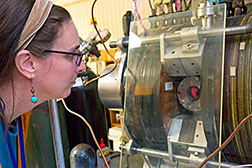- Number 438 |
- May 4, 2015
Synthetic muscle rockets to International Space Station

Lenore Rasmussen examines a titanium
coupon used in her synthetic muscle as the
metal is treated in an oxygen plasma at PPPL.
Lenore Rasmussen's dream of developing a synthetic muscle that could be used to make better prosthetic limbs and more responsive robots became airborne at 4:10 p.m. on Tuesday, April 14, when her experiment was launched aboard a SpaceX Falcon 9 rocket and Dragon spacecraft to the International Space Station National Laboratory from Cape Canaveral in Florida.
Rasmussen, a synthetic polymer chemist and founder of Ras Labs, has worked closely with researchers and engineers at DOE's Princeton Plasma Physics Laboratory (PPPL) to develop the material's ability to adhere to metal. The Synthetic Muscle™ could be used in robotics in deep space travel such as travel to Mars because of its radiation resistance.
"Based on the good results we had on planet Earth, the next step is to see how it behaves in a space environment," said Charles Gentile, a PPPL engineering and scientific staff member who has worked closely with Rasmussen. "From there the next step might be to use it on a mission to Mars."
Early connection with PPPL
Rasmussen began working with PPPL in 2007, four years after she started Ras Labs and nine years after receiving her first patent for a synthetic muscle. The muscle is made from a gel-like material called an electroactive polymer that can potentially mimic human movement by expanding and contracting. That ability would make it very useful in robotics and in developing better prosthetic limbs.
"We can't explore space without robots," Rasmussen said. "Humans can only withstand a certain amount of radiation so that limits the time that people can be in space, whereas robots, particularly if they're radiation-resistant, can be up there for long periods of time without being replaced."
Lew Meixler, the long-time head of Technology Transfer at PPPL who retired in March, said he has enjoyed helping Rasmussen follow her quest. "That's what entrepreneurs are," he said. "They're the dreamers who devote all their time, energy and resources to follow their dreams."
Rasmussen credits PPPL with providing help and support during critical points in her project. "It was and continues to be a wonderful resource not just because of the plasma physics but the people," she said. "Charlie and Lew found ways to make things happen."
Rasmussen solved a crucial problem during her work at PPPL: Getting the gel, which can be soft as jelly or hard as rubber, to adhere to the metal electrodes. Initially working with Meixler on a federal Cooperative Research and Development Agreement (CRADA) in the Plasma Surface Laboratory, she solved the problem by treating the electrodes with plasma. This changed the surface of the metal and made the gel adhere more closely to it.
PPPL was also involved with crucial tests of the material last summer, when the material was exposed to over 300,000 RADs of gamma radiation. That is 20 times the amount that would be lethal to a human and was equivalent to a trip from Earth to Mars and back. A second test of 45 hours was equivalent in radiation exposure to a trip to Jupiter and beyond.
Rasmussen and Gentile found that there was no change in the strength, electroacivity or durability of the material due to the radiation although there was a slight change in color. Tests on selected samples of the material found that it was not affected by extreme temperatures down to -271 degrees Celsius, which is close to absolute zero, the coldest temperature possible in the universe.
Preparing for launch
Since then, PPPL staff members had been involved in planning for the launch. This involved mapping out each detail with military precision. Several PPPL staff members, along with Rasmussen and her staff, signed the back of the metal container or coupon holding the material. "All of the people who worked on the lab signed it and the coupon will go into space," said Gentile. "So I'll be up there with Gene Roddenberry."
The polymer material will be kept in a zero-gravity storage rack in the space station laboratory for 90 days. The astronauts will photograph the materials every three weeks. When the material returns to Earth in July, it will be tested and compared with identical materials that remained on Earth.
Rasmussen is also exploring whether Synthetic Muscle™ could be used as a prosthetic liner, part of a lifelong quest to develop prosthetics materials that was inspired by her childhood experience seeing farm accidents and her recent experience of being at the 2013 Boston Marathon just half an hour before the bombing. The vestigial limbs of amputees can expand and contract during the day and the Ras Labs material is designed to expand and contract so it could make prosthetics more comfortable. She recently received a grant from the Pediatric Medical Device Consortium at the Children's Hospital of Philadelphia to research this possibility.[Jeanne Jackson DeVoe, 609.243.2757,
jjackson@pppl.gov]
